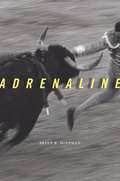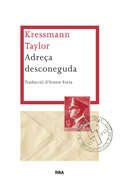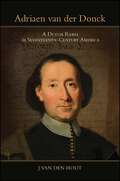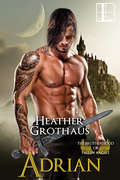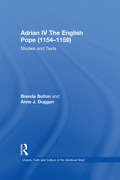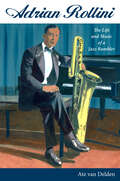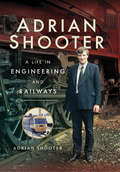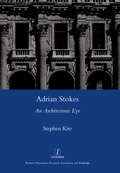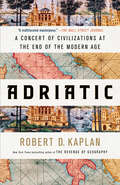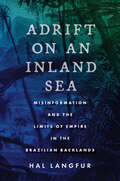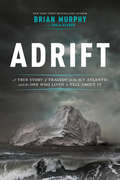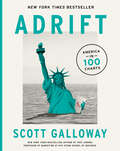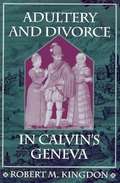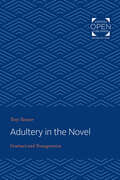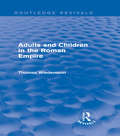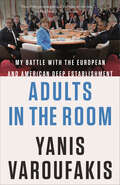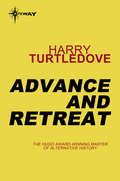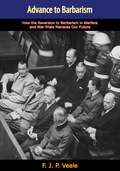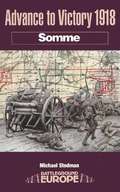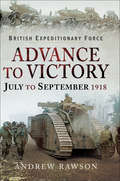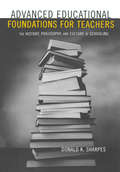- Table View
- List View
Adrenaline
by Brian B. HoffmanFamous as the catalyst of the fight or flight response, adrenaline has also received forensic attention as a perfect, untraceable poison-and rumors persist of its power to revive the dead. True to the spirit of its topic, Adrenaline is a stimulating journey that reveals the truth behind adrenaline’s scientific importance and popular appeal.
Adreça desconeguda
by Kressmann TaylorUna història escrita sense complaença ni demagògia que descriu la tragèdia íntima i col·lectiva de l’Alemanya nazi. 1932 L’alemany Martin Schulse i el jueu nord-americà Max Eisnestein s’estimen com a germans i han obert plegats una galeria d’art a Califòrnia. Però Martin decideix tornar a casa, de manera que Max es queda sol per ocupar-se del negoci. Es cartegen amb freqüència des del primer dia, però quan Hitler accedeix al poder el 1933 la complicitat de la primera correspondència va derivant cap a l’horror. Adreça desconeguda va publicar-se per primera vegada el 1938, i en poc temps va ser considerada una obra mestra. Visionària, incisiva, i de desenllaç imprevisible, aquest llibre va ser tot un esdeveniment literari, el senyal d’alarma més estremidor contra el nazisme. Ressenyes:«Una història absolutament perfecta.»The New York Times «Una lliçó de literatura.»El País
Adriaen van der Donck: A Dutch Rebel in Seventeenth-Century America (Excelsior Editions)
by J. van den HoutThis book tells the compelling story of the young legal activist Adriaen van der Donck (1618–1655), whose fight to secure the struggling Dutch colony of New Netherland made him a controversial but pivotal figure in early America. At best, he has been labeled a hero, a visionary, and a spokesman of the people. At worst, he has been branded arrogant and selfish, thinking only of his own ambitions. The wide range of opinions about him testifies to the fact that, more than three centuries after his death, Van der Donck remains an intriguing character.J. van den Hout follows Van der Donck from his war-torn seventeenth-century childhood and privileged university education to the New World, as he attempted to make his mark on the fledgling fur trading settlement. When he became embroiled in the politics of Manhattan, he took the colonists' complaints against their Dutch West India Company administrators to the highest level of government in the Dutch Republic, in what became a fight for his adopted homeland and a bicontinental showdown. Denounced and detained, but not deterred, Van der Donck wrote a landmark book that stands as a testament to his vision for the country, as the changes he set in motion continued long after his early death and his influence became firmly embedded in the American landscape. Van der Donck's determination to stand by his convictions offers a revealing look into the human spirit and the strong will that drives it against adversity and in search of justice.
Adrian (Brotherhood of Fallen Angels #2)
by Heather GrothausIn the medieval Holy Land, four brave Crusaders fight tyranny and betrayal. They are the Brotherhood of Fallen Angels--and one by one, they may discover that love is the greatest adventure of all... From palaces and cathedrals to fortresses, Adrian Hailsworth's engineering genius is evident across the land--including the castle of Chastellet. But a bloody siege has left the stronghold, and Adrian, in ruins. Now a wanted man, he is forced into hiding at The Brotherhood of Fallen Angels Abbey, his brilliant mind plagued with nightmares, his spirit broken--until Father Victor presents him with a fiery redhead in need of help only Adrian can give... Maisie Lindsay is the lady-in-waiting to the Queen of Wyldonna, a small kingdom off the Scottish coast that is being blackmailed--by none other than the Brotherhood's most treacherous enemy. The only chance of saving Wyldonna lies in unearthing its vast fortune, hidden within a labyrinth of deadly traps and secret passages. The challenge enlivens Adrian--as does the passion Maisie ignites. But she is far more than she appears, and the truth may force Adrian to sacrifice his heart's longing to save her, before it's too late for them all...
Adrian IV The English Pope: Studies and Texts (Church, Faith and Culture in the Medieval West)
by Anne J. Duggan Brenda BoltonThe year 2000 witnessed the 900th anniversary of the birth of Adrian IV, the only Englishman to sit on the papal throne. His short pontificate of four and a half years, distracted by crisis and controversy and followed as it was by an 18-year schism, could be judged a low point in the history of the papacy. The studies in this book challenge the view that Adrian was little more than a cipher, the tool of powerful factions in the Curia. This is the first large-scale work on Adrian since 1925, and is supported by a substantial appendix of relevant sources and documents in facing translation. Relations with the Empire, the Norman kingdom and the Patrimony are all radically reassessed and the authenticity of 'Laudabiliter' reconsidered. At the same time, the spiritual, educational and devotional contexts in which he was operating are fully assessed; his activities in Catalonia and his legatine mission to Scandinavia are examined in the light of recent research, and his special relationship with St Albans is explored through his privileges to this great abbey. These studies by leading scholars in the field, together with the introductory chapter by Christopher Brooke, reveal an active and engaged pope, reacting creatively to the challenges and crises of the Church and the world.
Adrian Rollini: The Life and Music of a Jazz Rambler (American Made Music Series)
by Ate van Delden2020 Association for Recorded Sound Collections Awards for Excellence—Best History in the category of Best Historical Research in Recorded JazzAdrian Rollini (1903–1956), an American jazz multi-instrumentalist, played the bass saxophone, piano, vibraphone, and an array of other instruments. He even introduced some, such as the harmonica-like cuesnophone, called Goofus, never before wielded in jazz. Adrian Rollini: The Life and Music of a Jazz Rambler draws on oral history, countless vintage articles, and family archives to trace Rollini’s life, from his family’s arrival in the US to his development and career as a musician and to his retirement and death. A child prodigy, Rollini was playing the piano in public at the age of five. At sixteen in New York he was recording pianola rolls when his peers recognized his talent and asked him to play xylophone and piano in a new band, the California Ramblers. When he decided to play a relatively new instrument, the bass saxophone, the Ramblers made their mark on jazz forever. Rollini became the man who gave this instrument its place. Yet he did not limit himself to playing bass parts—he became the California Ramblers’ major soloist and created the studio and public sound of the band. In 1927 Rollini led a new band that included such jazz greats as Bix Beiderbecke and Frank Trumbauer. During the Depression years, he was back in New York playing with several bands including his own New California Ramblers. In the 1940s, Rollini purchased a property on Key Largo. He rarely performed again for the public but hosted rollicking jam sessions at his fishing lodge with some of the best nationally known and local players. After a car wreck and an unfortunate hospitalization, Rollini passed away at age fifty-three.
Adrian Shooter: A Life in Engineering and Railways
by Adrian ShooterThis book is the tale of a small boy from Surrey who had a fascination with anything on wheels and, also, loved to learn about people and what motivated them. He read a lot about railways and was excited by the innovations of our nineteenth-century predecessors. When the Beeching report came out in 1963, he decided that he wanted to be a part of the new order and help bring back some of that excitement. He describes his upbringing and paints a picture of the 'greyness' of the 1950s and then takes the reader on a voyage of discovery into the world of 1960's engineering before he joined British Railway in 1970.The view from the inside presents readers with a whole new picture of what was really going on within British Rail at various levels. Much that is reported has never before been published and the reasons for many decisions on previously opaque matters are explained.The author was cautioned by his school careers master to be wary of saying what he really thought. It seems that this piece of advice has not been heeded.
Adrian Stokes: An Architectonic Eye
by Stephen Kite"Adrian Stokes (1902-72) - aesthete, critic, painter and poet - is among the most original and creative writers on art of the twentieth century. He was the author of over twenty critical books and numerous papers: for example, the remarkable series of books published in the 1930s; The Quattro Cento (1932), Stones of Rimini (1934), and Colour and Form (1937) that embraced Mediterranean culture and modernity. His criticism extends the evocative English aesthetic tradition of Walter Pater and John Ruskin into the present, endowed by a stern sensibility to the consolations offered by art and architecture, and the insights that psychoanalysis affords. Indeed, for Stokes architecture provides the entree into art, and this book is the first study to comprehensively examine Stokess theory of art from a specifically architectonic perspective. The volume explores the crucial experiences through which this architectonic awareness evolved; traces the influence upon Stokes of places, texts and personalities, and examines how his theory of art developed and matured. The argument is supported by appropriate illustrations to confirm the evidence that Stokess claim for architecture as mother of the arts carries the deepest experiential and psychological import."
Adriatic: A Concert of Civilizations at the End of the Modern Age
by Robert D. Kaplan&“[An] elegantly layered exploration of Europe&’s past and future . . . a multifaceted masterpiece.&”—The Wall Street Journal&“A lovely, personal journey around the Adriatic, in which Robert Kaplan revisits places and peoples he first encountered decades ago.&”—Peter Frankopan, author of The Silk RoadsIn this insightful travelogue, Robert D. Kaplan, geopolitical expert and bestselling author of Balkan Ghosts and The Revenge of Geography, turns his perceptive eye to a region that for centuries has been a meeting point of cultures, trade, and ideas. He undertakes a journey around the Adriatic Sea, through Italy, Slovenia, Croatia, Montenegro, Albania, and Greece, to reveal that far more is happening in the region than most news stories let on. Often overlooked, the Adriatic is in fact at the center of the most significant challenges of our time, including the rise of populist politics, the refugee crisis, and battles over the control of energy resources. And it is once again becoming a global trading hub that will determine Europe&’s relationship with the rest of the world as China and Russia compete for dominance in its ports. Kaplan explores how the region has changed over his three decades of observing it as a journalist. He finds that to understand both the historical and contemporary Adriatic is to gain a window on the future of Europe as a whole, and he unearths a stark truth: The era of populism is an epiphenomenon—a symptom of the age of nationalism coming to an end. Instead, the continent is returning to alignments of the early modern era as distinctions between East and West meet and break down within the Adriatic countries and ultimately throughout Europe. With a brilliant cross-pollination of history, literature, art, architecture, and current events, in Adriatic, Kaplan demonstrates that this unique region that exists at the intersection of civilizations holds revelatory truths for the future of global affairs.
Adrift on an Inland Sea: Misinformation and the Limits of Empire in the Brazilian Backlands
by Hal LangfurFrom 1750 until Brazil won its independence in 1822, the Portuguese crown sought to extend imperial control over the colony's immense, sea-like interior and exploit its gold and diamond deposits using enslaved labor. Carrying orders from Lisbon into the Brazilian backlands, elite vassals, soldiers, and scientific experts charged with exploring multiple frontier zones and establishing royal authority conducted themselves in ways that proved difficult for the crown to regulate. The overland expeditions they mounted in turn encountered actors operating beyond the state's purview: seminomadic Native peoples, runaway slaves, itinerant poor, and those deemed criminals, who eluded, defied, and reshaped imperial ambitions. This book measures Portugal's transatlantic projection of power against a particular obstacle: imperial information-gathering, which produced a confusion of rumors, distortions, claims, conflicting reports, and disputed facts. Drawing on interdisciplinary scholarship in the fields of ethnohistory, slavery and diaspora studies, and legal and literary history, Hal Langfur considers how misinformation destabilized European sovereignty in the Americas, making a major contribution to histories of empire, frontiers and borderlands, knowledge production, and scientific exploration in the eighteenth and nineteenth centuries.
Adrift: A True Story of Tragedy on the Icy Atlantic and the One Who Lived to Tell about It
by Brian Murphy Toula VlahouA story of tragedy at sea where every desperate act meant life or deathThe small ship making the Liverpool-to-New York trip in the early months of 1856 carried mail, crates of dry goods, and more than one hundred passengers, mostly Irish emigrants. Suddenly an iceberg tore the ship asunder and five lifeboats were lowered. As four lifeboats drifted into the fog and icy water, never to be heard from again, the last boat wrenched away from the sinking ship with a few blankets, some water and biscuits, and thirteen souls. Only one would survive. This is his story.As they started their nine days adrift more than four hundred miles off Newfoundland, the castaways--an Irish couple and their two boys, an English woman and her daughter, newlyweds from Ireland, and several crewmen, including Thomas W. Nye from Fairhaven, Massachusetts--began fighting over food and water. One by one, though, day by day, they died. Some from exposure, others from madness and panic. In the end, only Nye and the ship's log survived.Using Nye's firsthand descriptions and later newspaper accounts, ship's logs, assorted diaries, and family archives, Brian Murphy chronicles the horrific nine days that thirteen people suffered adrift on the cold gray Atlantic. Adrift brings readers to the edge of human limits, where every frantic decision and desperate act is a potential life saver or life taker.
Adrift: America in 100 Charts
by Scott GallowayFrom bestselling author, CNN+ host of No Mercy, No Malice, and NYU business school professor Scott Galloway comes an urgent examination of the future of our nation – and how we got here. <p><p>We are only just beginning to reckon with our post-pandemic future. As political extremism intensifies, the great resignation affects businesses everywhere, and supply chain issues crush bottom lines, we’re faced with daunting questions: Is our democracy under threat? How will Big Tech change our lives? What does job security look like for me? America is on the brink of massive change—change that will disrupt the workings of our economy and drastically impact the financial backbone of our nation: the middle class. <p><p>In Adrift, Galloway looks to the past —from 1945 to present day—to explain just how America arrived at this precipice. Telling the story of our nation through 100 charts, Galloway demonstrates how crises such as Jim Crow, World War II, and the Stock Market Crash of 2008, as well as the escalating power of technology, an entrenched white patriarchy, and the socio-economic effects of the pandemic, created today’s perfect storm. Adrift attempts to make sense of it all, and offers Galloway’s unique take on where we’re headed and who we’ll become, touching on topics as wide-ranging as online dating to minimum wage to the American dream. Just as in 1945 and 1980, America is once again a nation at a crossroads. This time, what will it take for our nation to keep up with the fast and violent changes to our new world? <p> <b>New York Times Bestseller</b>
Adulescentia: The eclogues of Mantuan (Routledge Revivals)
by Lee PiephoFirst published in 1989, Piepho has translated the Latin works of Mantuan’s eclogues, which play such a crucial role in the culture of Western Europe during the sixteenth and seventeenth centuries.
Adult Continuing Education and High School Course Catalog
by Hadley Institute for the Blind Visually ImpairedAdult Continuing Education and High School Course Catalog 2016-2017. Catalog of current distance education courses for the blind or visually impaired. Various media for the courses is available including; Braille, CD, Digital Talking Books, Large Print, Online and more. Not all courses are available in all formats.
Adultery and Divorce in Calvin’s Geneva (Harvard Historical Studies #118)
by Robert M. Kingdon<p>In Calvin's Geneva, the changes associated with the Reformation were particularly abrupt and far-reaching, in large part owing to John Calvin himself. Adultery and Divorce in Calvin's Geneva makes two major contributions to our understanding of this time. The first is to the history of divorce. The second is in illustrating the operations of the Consistory of Geneva--an institution designed to control in all its variety the behavior of the entire population--which was established at Calvin's insistence in 1541. This mandate came shortly after the city officially adopted Protestantism in 1536, a time when divorce became legally possible for the first time in centuries. <p>Robert Kingdon illustrates the changes that accompanied the earliest Calvinist divorces by examining in depth a few of the most dramatic cases and showing how divorce affected real individuals. He considers first, and in the most detail, divorce for adultery, the best-known grounds for divorce and the best documented. He also covers the only other generally accepted grounds for these early divorces--desertion. <p>The second contribution of the book, to show the work of the Consistory of Geneva, is a first step toward a fuller study of the institution. Kingdon has supervised the first accurate and complete transcription of the twenty-one volumes of registers of the Consistory and has made the first extended use of these materials, as well as other documents that have never before been so fully utilized.</p>
Adultery in the Novel: Contract and Transgression
by Tony TannerOriginally published in 1979. Adultery is a dominant feature in chivalric literature; it becomes a major concern in Shakespeare's last plays; and it forms the central plot of novels from Anna Karenina to Couples. Tony Tanner proposes that transgressions of the marriage contract take on a special significance in the "bourgeois novels" of the eighteenth and nineteenth centuries. His interpretation begins with the general topic of adultery in literature and then zeroes in on three works—Rousseau's La Nouvelle Héloïse, Goethe's Die Wahlverwandtschaften, and Flaubert's Madame Bovary. His interpretation encompasses the role of women, the structure of the family, social mores, and the history of sexuality.
Adultery: Infidelity and the Law
by Deborah L. RhodeDespite declining prohibitions on sexual relationships, Americans are nearly unanimous in condemning marital infidelity. Deborah Rhode explores why. She exposes the harms that criminalizing adultery inflicts--including civil lawsuits, job termination, and loss of child custody--and makes a case for repealing laws against adultery and polygamy.
Adults and Children in the Roman Empire (Routledge Revivals)
by Thomas WiedemannThere is little evidence to enable us to reconstruct what it felt like to be a child in the Roman world. We do, however, have ample evidence about the feelings and expectations that adults had for children over the centuries between the end of the Roman republic and late antiquity. Thomas Wiedemann draws on this evidence to describe a range of attitudes towards children in the classical period, identifying three areas where greater individuality was assigned to children: through political office-holding; through education; and, for Christians, through membership of the Church in baptism. These developments in both pagan and Christian practices reflect wider social changes in the Roman world during the first four centuries of the Christian era. Of obvious value to classicists, Adults and Children in the Roman Empire, first published in 1989, is also indispensable for anthropologists, and well as those interested in ecclesiastical and social history.
Adults in the Room: My Battle with the European and American Deep Establishment
by Yanis VaroufakisThe former Greek finance minister’s “deeply personal and very well written” account of negotiations over the Greek debt crisis (Financial Times).A #1 International BestsellerWhat happens when you take on the establishment? In Adults in the Room, the renowned economist and former finance minister of Greece Yanis Varoufakis gives the full, blistering account of his momentous clash with the mightiest economic and political forces on earth.After being swept into power with the left-wing Syriza party, Varoufakis attempts to renegotiate Greece’s relationship with the EU—and sparks a spectacular battle with global implications. Varoufakis’s new position sends him ricocheting between mass demonstrations in Athens, closed-door negotiations in drab EU and IMF offices, and furtive meetings with power brokers in Washington, D.C. He consults and quarrels with Barack Obama, Emmanuel Macron, Christine Lagarde, the economists Larry Summers and Jeffrey Sachs, and others, as he struggles to resolve Greece’s debt crisis without resorting to punishing austerity measures. But despite the mass support of the Greek people and the simple logic of Varoufakis’s arguments, he succeeds only in provoking the fury of Europe’s elite.Varoufakis’s unvarnished memoir is an urgent warning that the economic policies once embraced by the EU and the White House have failed—and spawned authoritarianism, populist revolt, and instability throughout the Western world. Adults in the Room is an extraordinary tale of brinkmanship, hypocrisy, collusion, and betrayal that will shake the global establishment to its foundations.“A gripping tale of an outspoken intellectual’s sudden immersion in high-stakes politics. . . . Varoufakis does a magnificent job of evoking the absurdities and frustrations of his tenure.” —Justin Fox, New York Times Book Review“Usually, books that are this heavily invested in financial minutiae don’t exactly keep you up at night, but Varoufakis’s account has the narrative drive of a rollicking detective novel.” —Stan Persky, The Los Angeles Review of Books
Advance And Retreat: Personal Experiences In The United States And Confederate States Armies [Illustrated Edition]
by Lt.-General John Bell HoodIncludes Civil War Map and Illustrations Pack - 224 battle plans, campaign maps and detailed analyses of actions spanning the entire period of hostilities."When John Bell Hood entered into the services of the Confederate Army, he was 29 years old, a handsome man and courageous soldier, loyal to the ideal of Confederate Independence and eager to fight for it. He led his men bravely into the battles of Second Manassas, Gaines's Mill, Sharpsburg, Fredericksburg, Gettysburg, and Chickamauga. He rose fast, attaining the temporary rank of full general, only to fall faster. Hood emerged from the war with his left arm shattered and useless, his right leg missing, his face aged far beyond his 33 years, and with his military reputation in disgrace. Blamed by contemporaries for contributing to the defeat of his beloved Confederacy, Hood struggled to refute their accusations. His most vehement critic, General Johnston, charged Hood with insubordination while serving under him and, after succeeding him in command, of recklessly leading Confederate troops to their "slaughter" and "useless butchery." Sherman, too, in his Memoirs, took a harsh view of Hood. Born of controversy, Advance and Retreat is of course a highly controversial book. It is also full of invaluable information and insights into the retreat from Dalton in early 1864, the fighting around Atlanta, and the disastrous Tennessee Campaign in winter of that year. Far from being a careful, sober, objective account, this book is the passionate, bitter attempt of a soldier to rebut history's judgment of himself as general and man."-Print ed.
Advance and Retreat
by Harry TurtledoveThe North shall rise again!When Avram became King of Detina, he announced his plan to liberate the blond serfs - and immediately plunged the kingdom into a long and bloody civil war, setting brother against brother. The northern provinces, dependent on the labour of their serfs, seceded, choosing Avram's cousin, Grand Duke Geoffrey, as their king. To save the kingdom, Avram sent armies clad in grey against the north, battling Geoffrey's army, arrayed in blue.Though King Avram held more land and wealth than Geoffrey, Geoffrey's men were better soldiers and the north had more powerful wizards. Still, as the war raged on, the greater population and the superior organisation of the South began to tell and the tide turned against the north.Even so, the war is far from over. The armies of the sough must now battle the north on its own ground - ground which will prove treacherous and deadly...
Advance to Barbarism: How the Reversion to Barbarism in Warfare and War-Trials Menaces Our Future [Revised Edition]
by F. J. P. VealeWidely regarded as his most important and influential work, Advance to Barbarism was first published in 1948 (under the pen name “A. Jurist.”), with a revised edition followed in 1953. It was issued in several languages, including Spanish and German.This eloquent work traces the evolution of warfare from primitive savagery to the rise of a “civilized” code of armed conflict that was first threatened in the US civil war, and again in the First World War, and was finally shattered during the Second World War.The ensuing “War Crimes Trials” at Nuremberg and Tokyo, and their more numerous and barbaric imitations in Communist-controlled Eastern Europe, Veale argues, established the perilous principle that “the most serious war crime is to be on the losing side.”Advance to Barbarism earned praise from some of the most astute thinkers of the age.“This is a relentlessly truth speaking book. The truths it speaks are bitter, but of paramount importance if civilization is to survive.”—Max Eastman“I have read the book with deep interest and enthusiasm. It is original in its approach to modern warfare, cogent and convincing… His indictment of modern warfare and post-war trials must stand.”—Norman Thomas“The best general work on the Nuremberg Trials. It not only reveals the illegality, fundamental immorality and hypocrisy of these trials, but also shows how they are bound to make any future world wars (or any important wars) far more brutal and destructive to life and property. A very readable and impressive volume and a major contributor to any rational peace movement.”—Harry Elmer Barnes
Advance to Victory, 1918: Somme (Battleground Europe)
by Michael StedmanThe Battleground series is designed for both the battlefield visitor and the reader at home. For the former, this book is an invaluable guide and each site is described in detail. For everyone there are graphic descriptions of action, often through first-hand accounts, supported by illustrations, diagrams and maps.
Advance to Victory, July to September 1918: July to September 1918 (British Expeditionary Force)
by Andrew RawsonThis is the story of the British Expeditionary Forces part in the opening days of the Advance to Victory. It starts with the contribution to the Battle of Fre-en-Tardenois in July; the counter-offensive which pushed the Germans back to the River Marne.Fourth Armys attack on 8 August was called the Black Day of the German Army, but it was only the beginning of 100 days of campaigning. The narrative follows the advance as it expands across the Somme, the Artois and the Flanders regions. Time and again the British and Empire troops used well-developed combined arms tactics to break through successive lines of defence. By the end of September, all five of the BEFs armies had reached the Hindenburg Line and were poised for the final advance.Each stage of the two month battle is given the same treatment, covering the details of the most talked about side of the campaign; the BEFs side. Over fifty new maps chart the day by day progress of the five armies and together with the narrative, explain the British Armys experience during the opening stages of the Advance to Victory. The men who made a difference are mentioned; those who led the advances, those who stopped the counter-attacks and those who were awarded the Victoria Cross. Discover the beginning of the Advance to Victory and learn how the British Army had mastered the art of attack.
Advanced Educational Foundations for Teachers: The History, Philosophy, and Culture of Schooling
by Donald K. SharpesSharpes' approach synthesizes historical, philosophical, and cultural standpoints. The text contains practical teaching applications alongside theory and an integrated emphasis of diversity and other multicultural themes. It also covers the history of schooling from ancient times to the present, including biographies of major non-Western figures as well as the canon of educational innovators.
